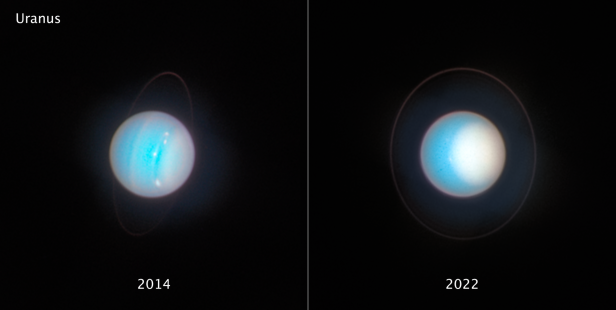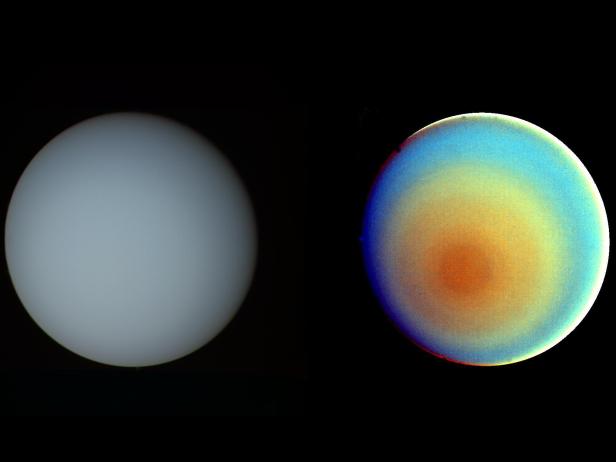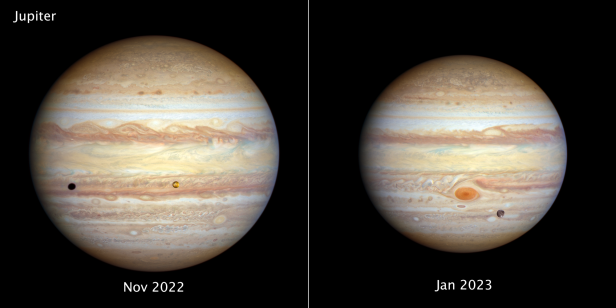© NASA, ESA, STScI, Amy Simon (NASA-GSFC), Michael H. Wong (UC Berkeley) IMAGE PROCESSING: Joseph DePasquale (STScI))
The Hubble Space Telescope not only looks into the depths of the universe, but also into our neighborhood. New recordings from Uranus and Jupiter now reveal more about the weather conditions on the planets in our solar system.
Icy smog on Uranus
The weather on the outer planets of the solar system is not as changeable as that on Earth. Nevertheless, researchers see changes in a direct comparison of new and old images. Thus, when comparing a Uranus image from 2014 with the new from 2022 an icy one smog hood recognize.
© NASA, ESA, STScI, Amy Simon (NASA-GSFC), Michael H. Wong (UC Berkeley) IMAGE PROCESSING: Joseph DePasquale (STScI)
The Ice Giant receives 400-mal less solar radiation than Earth. One suspects clouds Water and methane on the planet. The icy smog is on the northern hemisphere of the planet. The white hood is a”photochemical fog“, writes that Space Telescope Science Institute. This is with one smog bell comparable to what occurs in large cities on earth.
42 years without sunlight
It is difficult for researchers to study the formation and evolution of Uranus weather. Seasons last there up to 20 yearsthe next summer solstice takes place 2028 instead of. A year on Uranus lasts 87 earth years. This limits the amount of data researchers can access.
Because Uranus one just around 8 Grad has inclined axis, there are areas on the planet that are up to 42 years get along without sunlight. Photos of the Voyager probe from the 1980s show that the South Pole was pointing almost directly to the sun at that time. In the new images, the North Pole tilts toward the sun.
Voyager 2 photographed the southern hemisphere of Uranus in 1986
© NASA/JPL
Great Red Spot is shrinking
In addition to Uranus, Hubble also looked at the largest planet in our solar system, Jupiter. The researchers paid particular attention to the famous one Big Red Spot of the gas giant. It consists of a huge storm.
In the new image, the Great Red Spot is smaller than it has been in recent years 150 years since the beginning of the measurements. Despite this, it is still twice the size of Earth and reaches speeds of 430 to 680 km/h.
“Vortex Street” could produce a new giant storm
As the famous Great Red Spot weakens, a new storm could form. The researchers name a series of notable storms in the northern latitudes “vortex street“. They form a wave pattern of interconnected cyclones and anticyclones. Like gears, they move clockwise and counterclockwise.
On the left is the “Vortex Street” and the moon Io casting a shadow on the planet. On the right the shrinking Great Red Spot
© NASA, ESA, STScI, Amy Simon (NASA-GSFC), Michael H. Wong (UC Berkeley) IMAGE PROCESSING: Joseph DePasquale (STScI)
The researchers suspect that the storms could combine into a storm that could be at least as large as the Great Red Spot. However, it is very unlikely that the storm will actually form.
Hubble has been observing Jupiter since the 1990s. Scientists have only been able to show that the vortex street is forming in the last few years 10 years observe.



